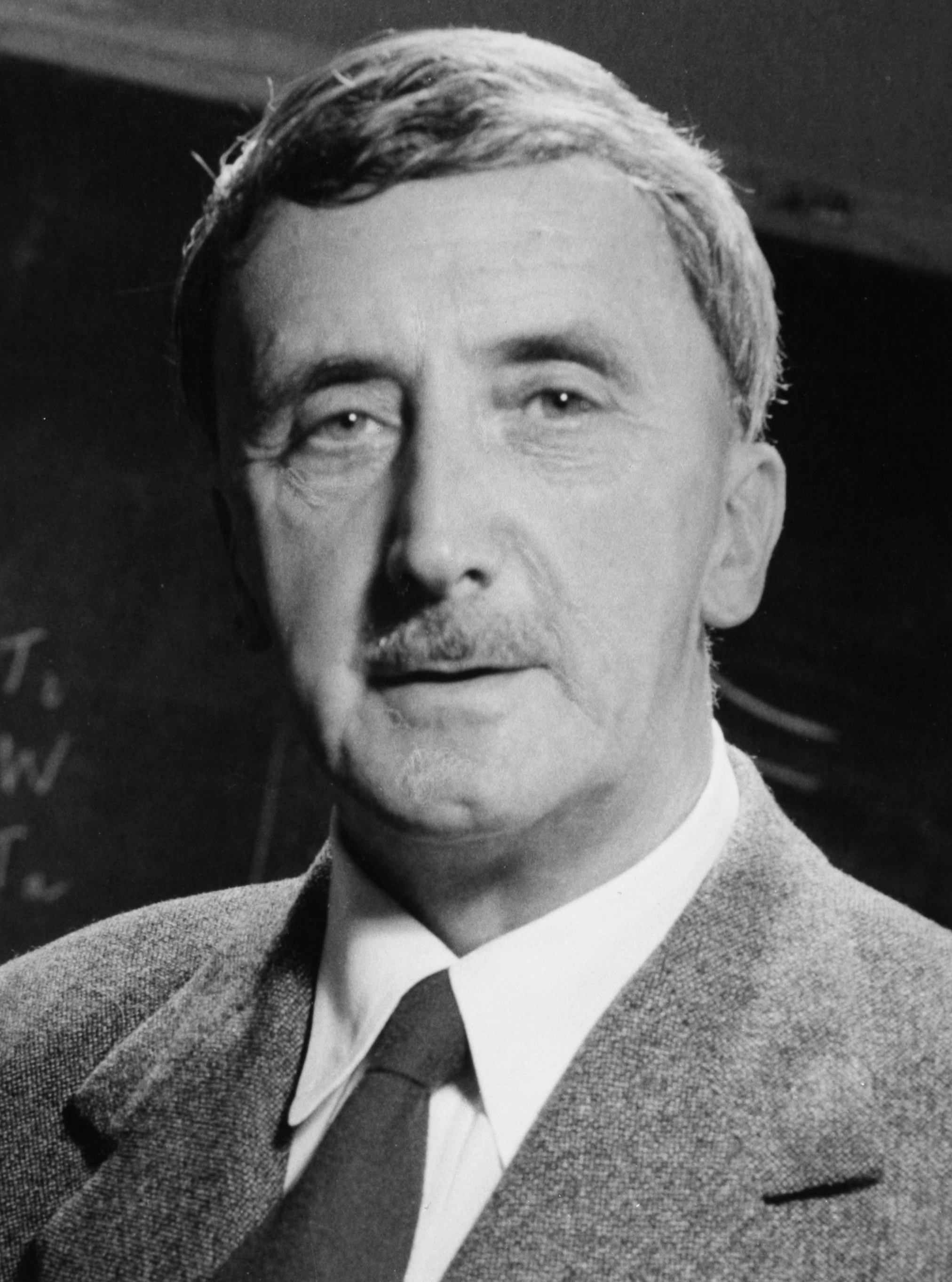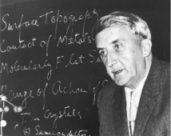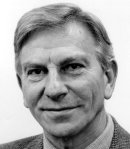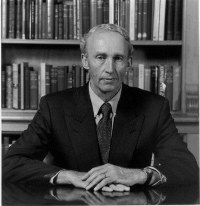Philip Bowden
Founder and Head of PCS 1945-1968
The Physics and Chemistry of Solids (PCS) Group was founded by Professor Philip Bowden. He was of Tasmanian origin and came to Cambridge in 1927 to do a PhD in electrochemistry. When he founded the group in 1945, it was known as the Physics and Chemistry of Rubbing Solids (PCRS) and was part of the then Department of Physical Chemistry. In 1957 Philip Bowden was made a Reader in Physics and his laboratory became a sub-department of the Cavendish Laboratory. Its name was changed at the same time to PCS. In 1966 Philip Bowden was given a personal chair in Surface Physics, so for a time the lab was known as Surface Physics. Philip Bowden died in 1968. His obituary was published in the Biographical Memoirs of Fellows of the Royal Society. A full list of his publications is available here. A link to an article published to commemorate the centenary of Philip Bowden's birth and reviewing his contribution to the Australian war effort may be found by clicking here
The present research interests of the group can be traced to research that Philip Bowden started in the 1930s (as a result of the influence of Sir W.B. Hardy) on a range of friction problems including:
- Frictional hotspots generated when dissimilar metals are slid over each other (being dissimilar they form a thermocouple junction allowing the temperature to be measured)
- The Beilby polishing layer.
- The range of surface forces.
- Friction of ice and snow (Bowden was a keen skier).
- In situ velocity measurement.
- Stick-slip motion.
In the summer of 1939 he went on a lecture tour of America and combined it with a trip to Australia to meet old friends and family. While he was in Australia, World War 2 broke out. So he offered his services to the Australian Government to set up a laboratory to help the Australian war effort, particularly on problems of friction, lubrication, bearings and wear. The lab co-operated with a bearing manufacturer to help produce effective bearings for the newly developing aircraft industry in Australia.
In 1941, he was introduced to another topic that was later to play an important part in PCS after the war ended. The Australian munitions industry was concerned about an unexplained detonation of a vat of nitroglycerine at the ICI factory at Deer Park near Melbourne causing serious damage to the factory and precincts. Nitroglycerine was used for the preparation of dynamite and blasting gelatine. A.D. (Abe) Yoffe joined in late 1941 to carry this study forward. The experiments of ADY (together with Maurice Mulcahy and Bob Vines, who joined in 1942) led to the discovery of the very large sensitizing effect of the presence of tiny gas bubbles in nitroglycerine. This led to the publication of the famous book "Initiation and Growth of Explosion in Liquids and Solids" by Bowden & Yoffe, published by Cambridge University Press in 1952. Their conclusion concerning the Deer Park disaster was that it was due to the 'water hammer effect' caused by adiabatic compression of gas inclusions in piping leading away from the vat where the nitroglycerine was made. Later research on the initiation of solid explosives by friction led to the concept of 'hot spots' as the necessary condition for initiation to occur (Bowden, F.P., Stone, M.A. and Tudor, G.K. "Hot spots on rubbing surfaces and the detonation of explosives by friction", Proc. R. Soc. Lond. A188 (1947) 329-349).
In studying how fast-moving particles could produce detonation, two of Bowden’s engineer graduates developed an electronic device for measuring the velocity of particles by determining the time of flight between two points in the flight path. In due course this led Jeof Courtney-Pratt to develop portable equipment which could be placed on the decks of battle-ships and used to measure the muzzle velocity of naval guns on the ship itself. He calibrated the guns of the Australian Navy and was dispatched to England to do the same for the Royal Navy.
At the end of the war, Philip Bowden returned to Cambridge and became a lecturer in the Department of Physical Chemistry. He brought with him some of his more experienced scientists from Australia, including David Tabor, Abe Yoffe, Jeof Courtney-Pratt, and Alan Moore. They were soon joined by some graduates from Cambridge and other universities. The programme was very much a continuation and development of work in Melbourne, and it is significant that Bowden called it the Physics and Chemistry of Rubbing Solids. The main areas of work were initially friction, lubrication, and chemical decomposition produced by friction and analogous processes. These studies gradually developed to include the erosion of solids by liquid impact, the strength and fracture of solids, the effect of molecular structure on the chemical stability of explosives, and the relation between structure and the optical and electronic properties of solids.
Within five years or so the laboratory was beginning to develop its own character. Alan Moore was developing taper sections; Brent Greenhill was studying EP lubrication with chlorine and sulphur-based additives; Eric Tingle was looking at the protection offered by oxide films; Ernst Rabinowicz introduced radioactive tracers to study adhesion and transfer; Jim Menter started the use of the earlier type of electron diffraction equipment to study surface films, and later modified an existing electron microscope in reflexion to product the first direct observation of dislocations; Anita Bailey and Jeof Courtney-Pratt introduced mica as a model surface; Peter Gray demonstrated the rôle of the vapour phase in the detonation of liquid explosives; Abe Yoffe extended his study of explosive reactions to the structure of azides and later to the electronic properties of layered solids. In the background there was increasing use of Jeof Courtney-Pratt’s image-convertor cameras to study high-speed phenomena in detonation and in mechanical erosion.
In the early 1950s, Nevill Mott was appointed Cavendish Professor. Nevill Mott was the father of solid state physics in the UK. Although a theoretician, he had close contacts with industry and had been involved in many wartime activities. He not only solved the problem of how photographic processes occur, he worked on dislocations and wrote a seminal paper on fragmentation. He understood Philip Bowden’s interests and approach. They were also both Fellows of Gonville & Caius College. As a result of discussions between them, Philip Bowden resigned from Physical Chemistry and was taken on by the Cavendish. Nevill Mott gave strong support to the lab and encouraged its involvement in the study of the electronic properties of layered materials.
Bowden’s lab was the first University group that was interdisciplinary in its research (long before that word was invented). This initially gave rise to some problems, particularly in relation to teaching, supervisions, and examining; but these were gradually resolved. However, there were few difficulties about research funding because of Bowden’s wise choice of research themes and because of the confidence that industrialists had in his projects. One might in fact describe Philip Bowden as a scientific entrepreneur. He was extraordinarily successful in winning the support of Industry and Government departments.
David Tabor
Head of PCS 1968-1981
On Bowden’s death in 1968, David Tabor took over as the second head of the group. At that time, his research interests lay predominantly in the areas of friction, lubrication and indentation hardness. Over time his interests branched out to include machining, ice, polymers, and surface physics. The latter two topics resulted in the formation of two new research groups in the Cavendish (The Tabor Laboratory for Polymers and Colloids, headed by Professor Athene Donald and Optoelectronics, headed by Professor Sir Richard Friend. His interest in surfaces eventually led to the formation of the Surface Physics subgroup within PCS Surface Physics (headed by Dr Roy Willis and then Bill Allison) which developed techniques to study surfaces in their own right rather than their frictional interactions.
Under his leadership, PCS grew to become the second largest research group in the Cavendish (after Radio Astronomy). It consisted of four subgroups: Solid State Physics (headed by Abe Yoffe), Fracture (headed by John Field), Surfaces (headed by Roy Willis and then Bill Allison), and Polymers (headed by Athene Donald).
David Tabor retired in 1981 and died in 2005. His obituary was published in the Biographical Memoirs of Fellows of the Royal Society. A full list of his publications is also available as is an article outlining his contributions to the study of hardness and indentation.
Abe Yoffe
Head of PCS 1981-1987
On David Tabor’ retirement in 1981, Abe Yoffe became head of the PCS Group. Over time his research interests had moved away from his war-time work on explosives into the electronic properties of matter, particularly layered materials (such as dicalcogenides) and amorphous metals. He fostered and encouraged Richard Friend’s interests in electrically conducting polymers which eventually led to the formation of the Optoelectronics Group in the Cavendish as well as a spin-off company (Cambridge Display Technology). He retired as Head of the PCS Group in 1987.
John Field
Head of PCS 1987-2005
John Field became Head of PCS on Abe Yoffe’s retirement in 1987. His research interests lay largely in the high rate mechanical properties of matter and were largely, although not exclusively, funded by the defence industry. The sub-group he headed was for a time known as the Fracture Group. In the mid-1990s ‘Shock’ was added to the name of his sub-group as a result of the design and construction of a plate impact facility under the leadership of Neil Bourne. John Field has co-authored 460 papers on subjects as diverse as brittle fracture, explosives, mechanical properties of diamond, rock blasting, laser damage, liquid impact erosion, solid particle erosion, high-speed photography, optical techniques, high strain rate mechanical properties, and shock physics. During his time as Head of PCS, two sub-groups established themselves as independent research groups within the Cavendish, namely Polymer and Colloids (headed by Athene Donald) and Optoelectronics (headed by Richard Friend).
The group today
A massive expansion in research output has led to various research groups - from Biological and Soft Systems to Optoelectronics - branching out from the historic PCS group. As a result, the group was renamed 'Surfaces, Microstructure and Fracture' to better reflect current research interests - with Surface Physics specialising in picosecond timescale measurement of atom dynamics on surfaces (primarily with helium spin-echo and more recently helium microscopy), while Fracture and Shock Physics continues Boweden's legacy with interests in rate-dependent deformation and failure of inert, structural and energetic materials.
In the academic year 2017/18, research at the Cavendish was reorganised to better reflect both the highly interdisciplinary nature of modern science. Principally, this has involved replacing the historical 'research groups' in the formal departmental structure with broader 'research themes'. At the day-to-day level, research is generally organised by Principal Investigators (university teaching officers and senior researchers) either individually or in small groups. This new website was therefore designed to better align with this approach, and reflect more accurately on the day-to-day organisation of research here.





